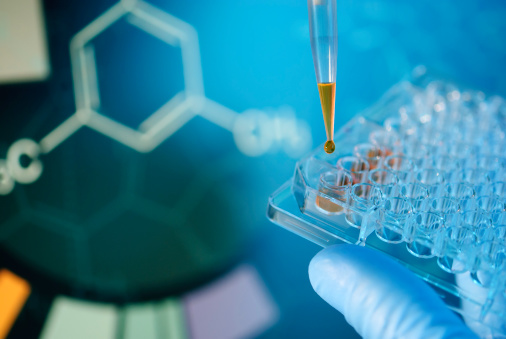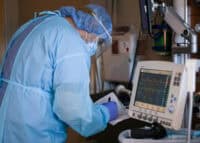The biotech sector has seen its valuations hit hard in many cases in 2014, but many investors remain excited about the future wave of big biotech drugs — and big biotech profits. The Holy Grail term for a drug in biotech and pharmaceuticals alike is the so-called blockbuster drug, those products which generate $1 billion or more in annual sales. It is these drugs that often excite investors the most.
24/7 Wall St. wanted to evaluate the prospects for several would-be blockbuster drugs. Some of these have approvals already in hand, while others have pending U.S. Food and Drug Administration (FDA) approval verdicts or expanded indications coming soon.
In December of 2013, an approval from the FDA of Sovaldi for its treatment of hepatitis C infections put Gilead Sciences Inc. (NASDAQ: GILD) on track for a potential blockbuster several times over. Sovaldi generated more than $2 billion in sales in its first quarter of full approval alone. The cost of this drug has raised enough eyebrows that congressional inquiries have been made. Another recent blockbuster crossover is from Cubist Pharmaceuticals Inc. (NASDAQ: CBST), whose Cubicin, which treats hospital-borne infections, has now crossed over the line of $1 billion in annual sales.
There are several questions to ask about future blockbuster drugs. The first of course is which drug treatment from which company? Will they get FDA for European marketing approval? Also, how long will these drugs take to become blockbuster drugs? Lastly, what are companies spending in the key research and development (R&D) to get these drugs through approval and to the market?
Having a potential blockbuster comes with much hope, but it also comes with much risk. Not all blockbuster wannabes actually become blockbuster drugs. Some drugs even flop, or they get eaten alive by new competition. It was once believed that Dendreon Corp. (NASDAQ: DNDN) would have a blockbuster on its hands with Provenge for prostate cancer. Unfortunately, the prostate cancer treatment was delayed by the FDA for so long and the drug adoption rate by physicians was low enough (with a price tag of nearly $100,000) that this turned into another Boulevard of Broken Dreams for investors.
Here are 10 potential blockbuster drugs in various stages of approval or marketing.
Aegerion Pharmaceuticals
> Drug: Juxtapid for homozygous familial hypercholesterolemia (HoFH)
Aegerion Pharmaceuticals Inc. (NASDAQ: AEGR) is aiming to target novel therapeutics to treat debilitating and fatal rare diseases, specializing in orphan drugs that in some cases often require less strenuous testing by the FDA. The company’s Juxtapid drug treating familial hypercholesterolemia could potentially generate more than $1 billion in peak sales. J.P. Morgan sees $600 million in sales by 2017. That being said, this is likely a long way off, but 2014 sales are expected to rise more than 300% to $200 million and almost double again in 2015 to more than $380 million. Aegerion has spent a combined $87 million in R&D over the past four years.
ALSO READ: UBS Top Picks for Cancer Cures
Celgene
> Drug: Otezla for psoriatic arthritis (and psoriasis)
Celgene Corp. (NASDAQ: CELG) likely has a blockbuster on its hands now that the FDA approved Otezla for the treatment of active adult psoriatic arthritis. This approval was just in March of 2014, but it has a twist ahead for a broader indication. The driving force here is that Otezla is the first and only approved oral treatment for this indication. Celgene will be competing against products like Humira, Remicade, Enbrel and others. What may be the real catalyst is that Otezla is being reviewed for a broader psoriasis indication, and this approval decision is not expected to come until late in the third quarter of 2014. Celgene is already one of the largest biotechs in the world by market cap (about $60 billion) with other products on the market, and the company’s total R&D spending across all existing drugs and pipeline drugs has added up to almost $6.7 billion over the past four years combined.
GW Pharmaceuticals
> Drug: Sativex, a cannabinoid medicine, for MS spasticity, cancer pain and neuropathic pain
GW Pharmaceuticals PLC (NASDAQ: GWPH) is no typical pharma or biotech stock, nor is it a mere legalized marijuana or medical marijuana stock. The stock recently flew higher on a dual upside endorsement after Morgan Stanley assigned more than 100% upside, followed by another Jim Cramer endorsement on CNBC. GW Pharma is involved in developing cannabinoid prescription medicines, and sales were not even $50 million in 2013. In late 2013, the firm Lazard hinted that expanded approvals in the United States and elsewhere could ultimately reach the blockbuster status if additional approvals come. Sativex is currently available by prescription for MS spasticity in 11 countries, and it has regulatory approval in 13 more countries with anticipated commercial launches mostly in 2014. The U.K.-based company has spent more than 100 million British pounds on R&D over the past four years combined.
Intercept Pharma
> Drug: obeticholic acid (OCA) in an experimental model of liver disease
Intercept Pharmaceuticals Inc. (NASDAQ: ICPT) has been incredibly volatile, and its stock at one point was up more than 1,000% from its lows of 2013. Even After losing 40% from its peak, it is valued at more than $5 billion now. Intercept’s lead candidate OCA in liver fibrosis (NASH) met its primary endpoint to target a multibillion dollar market with no approved drugs. NASH is believed by some to be one of the last few remaining large markets. To prove the point: the data announcement alone sent shares from under $75 to well above $400 in two trading days. Intercept has spent just under $60 million in R&D in the past four years, so it could have a serious profit. Just don’t expect a final outcome any time soon. OCA is being developed for a variety of chronic liver diseases and patient populations including, PBC, PSC, NASH, cirrhosis, portal hypertension, alcoholic hepatitis and bile acid diarrhea.
Ironwood Pharmaceuticals
> Drug: Linzess, linaclotide, for irritable bowel syndrome with constipation (IBS-C) or chronic idiopathic constipation (CIC)
Ironwood Pharmaceuticals Inc. (NASDAQ: IRWD) is just getting things going with its Linzess, or linaclotide, for IBS and CIC as a once-daily treatment for adults. Ironwood’s market value is almost $1.5 billion, and it has had limited revenues. Linzess could ultimately become a leading player in next-generation treatment for chronic constipation and IBS, but sales are expected to rise almost 250% to about $80 million in 2014 and another 130% to more than $181 million in 2015. In short, this may take years to become a blockbuster. Credit Suisse recently saw 50% upside to the stock when its early April report came out. Ironwood has spent more than $350 million in total R&D expenses in the past four years.
ALSO READ: Nine Stocks That Could Double in 2014
Lpath
> Drug: iSONEP in wet age-related macular degeneration
Lpath Inc. (NASDAQ: LPTN) is such a small company (worth well under $100 million) and is hardly known, making it hard to cover without some serious caveats. The first is that getting a blockbuster drug from a $67 million valued company seems hard to imagine. That being said, Canaccord Genuity recently issued a research report calling for a massive upside of about 300%. Another analyst sees it rising closer to 200%. iSONEP was touted as having a shot of being paradigm-changing in wet AMD (age-related macular degeneration), with some $2.4 billion in peak sales potential. Phase 2 data are not due until late in 2014, so it is potentially two years or more before an outcome is known. Lpath’s R&D spending has been only about $37 million combined over the past four years.
MannKind
> Drug: Afrezza as inhalable insulin for diabetes
MannKind Corp. (NASDAQ: MNKD) has tried to get its Afrezza approved by the FDA for years. If approved, this would be the only approved inhalable insulin treatment on the market. The company has spent more than just in the hundreds of millions in testing and studies, and the FDA keeps pushing back. As of mid-April, the chances of an FDA approval rose after an FDA panel overwhelmingly suggested that it be approved. Diabetes spending is in the hundreds of billions each year, and billions are spent on insulin. Afrezza sales can easily jump into the billions of dollars if it is approved, and if there are no serious reactions by users. MannKind’s R&D tally has been nearly $380 just in the past four years, and well over a billion since it began.
ALSO READ: Jefferies Top Biotech Picks for Breakthrough Drug Innovations
Medivation
> Drug: Xtandi in prostate cancer
Medivation Inc. (NASDAQ: MDVN) has a top prostate cancer drug in the already-approved Xtandi, also with potential upside treatment indications in breast cancer. There has been at least some hope that Medivation could even be a valuable acquisition target, calling it a highly leverageable likely blockbuster product in prostate cancer. The company is already expected to move into profitability in 2014 after Xtandi was approved by the FDA in 2012, and its total company sales are expected to double to nearly $550 million this year and rise more than 40% in 2015 to almost $780 million. Xtandi is under an extended European Marketing Authorization Application approval process. Medivation is worth close to $5 billion already, and the company has spent $360 million in R&D in the past four years.
Questcor
> Drug: H.P. Acthar injectable gel, approved for 19 different conditions
Questcor Pharmaceuticals Inc. (NASDAQ: QCOR) is in the process of being acquired by Mallinckrodt PLC (NYSE: MNK), but the outcome of this merger is not yet known. The reason for the buyout is that this one-trick pony’s (more or less) H.P. Acthar injectable gel has been approved as a treatment for 19 different conditions. Many of the approvals are associated with autoimmune and inflammatory conditions, and the list of treatment indications just seems to keep growing. The company’s sales of almost $800 million in 2013 are up almost fourfold from 2013, and the company is expected to generate sales of $1.06 billion in 2014 and more than $1.2 billion in 2015. The company spent just over $110 million in R&D in the past four years combined, but Acthar’s manufacturer BioVectra was bought by Questcor.
ALSO READ: Biotech and Pharma’s Top Buyout Candidates
Sarepta Therapeutics
> Drug: eteplirsen for Duchenne muscular dystrophy (DMD)
Sarepta Therapeutics Inc. (NASDAQ: SRPT) is a very controversial company, with a very volatile stock history over the past year after FDA disappointment, followed by a more recent favorable FDA reversal. Eteplirsen indication for Duchenne muscular dystrophy is one of those strange categories of rare disease treatments. DMD puts boys in wheelchairs, ultimately to die in their early 20s, and it impacts about 15,000 boys in the United States. Amazingly, the drug has been well tolerated even if it stopped working in some patients. Barron’s recently suggested that eteplirsen could become the basis for a family of DMD drugs, and the financial journal said that it could have several billion dollars worth of revenue from it if the drug is approved. It may not be until 2015 before this outcome is known, and Sarepta’s R&D program has spent more than $225 million just in the past four years.
Get Ready To Retire (Sponsored)
Start by taking a quick retirement quiz from SmartAsset that will match you with up to 3 financial advisors that serve your area and beyond in 5 minutes, or less.
Each advisor has been vetted by SmartAsset and is held to a fiduciary standard to act in your best interests.
Here’s how it works:
1. Answer SmartAsset advisor match quiz
2. Review your pre-screened matches at your leisure. Check out the advisors’ profiles.
3. Speak with advisors at no cost to you. Have an introductory call on the phone or introduction in person and choose whom to work with in the future
Thank you for reading! Have some feedback for us?
Contact the 24/7 Wall St. editorial team.



